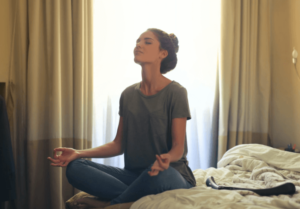One of the best ways to combat stress and anxiety is by learning how to breathe correctly. Breathing helps you regulate your emotions, fight fatigue, and lower blood pressure. It can also help you get a good night’s sleep. We will discuss deep breathing techniques that are so simple anyone can master them in just minutes.
How To Breathe Properly And Why It’s Important To Your Health
Breathing deeply and relaxing your muscles is the ultimate self-soothing technique. It can help you remain calm, lower blood pressure, relieve stress and anxiety. Deep breathing also helps release toxins from our bodies that are causing us to get sick or suffer pain.

When you meditate, it’s best to not only focus on your breath but also engage in a favorite activity. For example, you can create a mantra about what you’re grateful for and repeat it while breathing deeply.
The thing that makes deep breathing so compelling is how it trickles down into our whole body, or we do with our diaphragm, allowing us to take deeper breaths than average without any extra effort. The natural extension of this technique is using visualizations such as imagining yourself floating on water, climbing stairs, or rolling through hay bales – whatever calms you down the most.
If all else fails, close your eyes and imagine taking one prolonged slow inhalation followed by an equally long exhalation until your lungs are empty and your stomach is full.
The most important thing to remember about how to breathe properly is that the goal isn’t to take in as much air as you can, but rather to relax by taking slow breaths from our diaphragm – a technique we’ve been using since way before it was fabulous! If you’re not sure where this muscle lives on your body, place one hand under your ribcage and press up towards the bottom of the breastbone.
Doing so will cause all of those muscles around your ribs and back to loosen up slightly, which provides more room for our chest cavity (and let’s be honest: less stress!). This relaxed state also reduces tension throughout other parts of the brain and body, which is why deep breathing is so beneficial.

Breathe in through your nose for a count of four, and then exhale slowly out of your mouth over six seconds. Repeat this cycle three times, and you’ll notice that not only are you more relaxed, but also come up with better ideas or solve problems!
How To Breathe Properly: Tips And Techniques For Practicing Deep Breathing
Deep breathing is an essential part of a healthy lifestyle. It can help reduce stress, improve mood and even ease symptoms of depression. Here are some tips for getting started with deep breathing:
Sit in a comfortable position and close your eyes to focus on the breath coming into and out of the body from one nostril at a time (alternate which side you breathe through). This will allow each lung to inflate before air moves to the other side entirely. You may choose to place your hands along either side of your rib cage so that you feel it rise when drawing in air and fall as you expel it, or use any hand gestures that work best for you during this process but do not physically move them up or down or in and out of the body.

Once you can focus on your breath without distractions, count each inhalation from one to five and then do the same for exhalations until you reach ten (or more). For this exercise, it’s essential not to be hard on yourself if thoughts come into your head or there is a moment where you lose track of how many breaths have been taken so far. From time to time, when we practice deep breathing as part of our meditation routine, our minds wander off, and that’s okay! The key here is just being aware that this happens and gently bringing back our attention with an awareness mantra such as ‘I am’ or ‘here I am.’
We should also be aware of the following:
- Deep breathing is one way to calm a nervous system that might be overreacting or stressed.
- Slow, deep breaths can improve circulation and reduce inflammation in our lungs. – Breathing from your diaphragm – by taking long, slow breaths low in the abdomen – not only helps keep you calm but also provides more oxygen for your organs and muscles to function better. The result? Less stress on these body systems leads to decreased symptoms such as pain, fatigue, anxiety, and depression.
When we breathe deeply during meditation practice, we are improving blood flow through our bodies while at the same time calming the nervous system.
A common misconception is that deep breathing will make it worse if you are feeling tense or stressed and increase feelings of stress in the body. Contrary to this belief, studies show that when we breathe deeply from our stomachs – by taking long slow breaths low in the abdomen. These exercises help us feel more relaxed, but they also provide essential oxygen for our organs and muscles, leading to decreased symptoms such as pain, anxiety, and depression.
- Breathing through your nose always helps keep a calm state better than mouth breathing since there’s less chance of air rushing up into your sinuses.
- When practiced regularly over time, mindful meditation can reduce anxiety and help you build up mental resilience.
- The best time to do these exercises is at the end of a stressful day or before bedtime. Doing them in this way will make it easier for your body to let go and sleep peacefully later on.
Deep breathing techniques are simple yet powerful ways that can be done anywhere! Once you know how to breathe properly and the importance of why deep breaths come from our stomachs by taking long and slow inhales low down near the abdomen, making us feel more relaxed and providing essential oxygen for our organs and muscles. When practiced regularly over time, mindful meditation reduces anxiety and helps you develop greater mental resilience.
The best time to do these exercises is to feel stressed out or exhausted after a long day or before bedtime. This will make it easier for your body to let go and sleep peacefully later on.
Final Words
Deep breathing techniques can help us find calm amidst chaos by slowing down our heart rate and releasing stress hormones like cortisol from our bodies. These methods can also improve concentration skills as well as creativity – making life easier for everyone involved! Hopefully, these instructions on how to breathe properly will assist you in creating some space between yourself and any other stressful situation without resorting to anything else.
If you want to learn how to use a singing bell for your next meditation, we also have a dedicated blog just for you.
